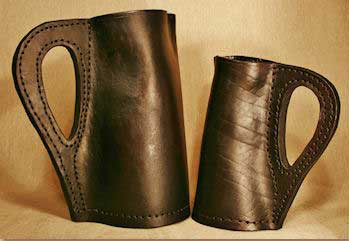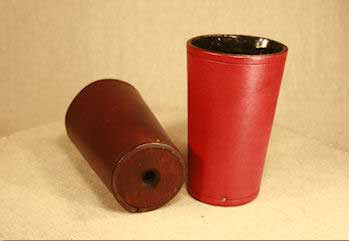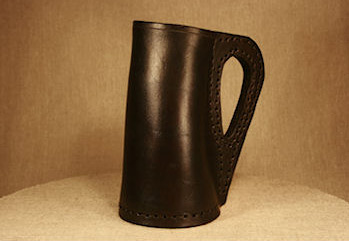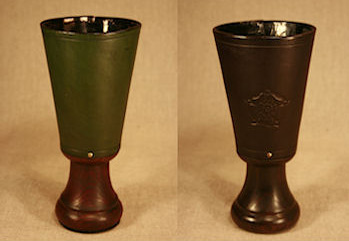Tankard Facts
Product Specification
|
Small Jack and Thumb beaker both approx 11cms. Capacity approximately one pint and half a pint respectively.
|
A large Tankard is approx 15 cms high and a small Tankard is approx 11cms high. Capacity approximately one pint and half a pint respectively. |
|
A Large Bombard is approximately 29 cms high with a base diameter of approximately 15 cms. A Small Bombard is approximately 24cms high with an approximate base diameter of 13cms. Capacity approximately four pints and two pints respectively. |
A Key Stone Beaker is approximately 13 cms with a base of approximately 6cms. Capacity approximately half a pint.
|
|
Early medieval Jack is approximately 18 cms high. Capacity approximately one pint. |
A Goblet is approximately 17 cms high. Capacity approximately half a pint. |
Internal Linings
Historically, leather Tankards and Jacks were lined with the boiled resin of birch / pine trees or brewers pitch. We have used brewers pitch for many years, but that material has recently been withdrawn from the market.
Resin
We are now lining our full grain leather drinking vessels with an epoxy resin which is fully certified for use in both the food and alcohol industries. This new material brings us far closer to the historical material in that they are both resins.
This resin is very much stronger than was the brewers pitch and has resulted in a most acceptable upgrade in the quality of our goods. The resin looks just like the pitch and like the pitch will have no effect on your drink what so ever.
Brewers Pitch
Historically Hidebound vessels were waterproofed, or beer proofed, with brewer's pitch, being the traditional method of caulking wooden beer casks, or lining water tanks and pipes.
Brewer's pitch is an oil-based product purified by having hot oxygen blown through it. It is acceptable in contact with cold consumable liquids when the contact is transitory and not long-term storage, as ale and wine normally is, at least in the leather tankards as used by us!
We currently have a finite stock of pitch lined vessels and a growing stock of resin lined vessels. If you have a specific preference for a pitch lined vessel, please contact us here to enquire about the stock levels of specific items. We will do our best to accommodate your request.
Our pitch lined vessels are finished with stitching around the base.
Vessel Capacity
Both tankards and jacks are offered in large and small sizes approximating to pint and half pint capacity respectively. Bombards are also offered in large and small sizes approximating to 4 pint and 2 pint capacity. Key Stone Beakers are offered with an approximate capacity of a third of a pint. None of our vessels are sold as legal measures because the manufacturing variables do not allow them to be Crown Stamped.
Historical Period
Throughout history, certain periods have been designated a name, dependent upon their dominant culture.
Viking times are generally referred to as occupying the 8th to 10th Centuries.
The Medieval period can be said to run from roughly from the 8/9 Centuries to the mid 15th century .
Tudor times are taken as referring to Henry VIII but in fact began in 1485 when the forces of Henry VII beat those of Richard III at the Battle of Bosworth Field in 1485 which resulted in Richard's death.
Medieval Jacks were used from Medieval periods through to the time of the Crimean War, whereas Tudor Tankards were used from Tudor Times onwards. The chronological point is that early designs could be used after that period but later designs, obviously, could not be used before their allotted period.
Maintenance
Wash by swilling out with clear cold water and clean the outside with a wet cloth.
DO NOT immerse in water as the leather dye may leach. This is not considered a fault.
Use ONLY FOR COLD drinks.
Do not attempt to squeeze the vessel. If it were made of glass you would not squeeze it because you would know the result. The same thing can happen to the lining, simply treat it as though it were made of glass.
Repairs, Re-pitching, and Re-resining
We are usually able to re-pitch vessels for you if you have cracked the lining. However, as we are no longer able to obtain Brewer's Pitch this service will, unfortunately, soon have to be permenantly removed.
However, at your own risk, it may be worth trying to repair it by smoothing over the crack with a hot knife blade. Careful use of a gas powered blow torch can be beneficial by slightly softening the surface to make it more receptive to the hot knife treatment. Be sure you do not overheat the vessel because it can cause scorching of the outside surface of the leather for which we cannot be held responsible.
You must be very careful and take all necessary cautions. Please be aware that if you do attempt a repair, you undertaken it with the acceptance of all risk. Hidebound cannot be held responsible for any accident or injury.
We are also able to repair the resin lining of vessels for you if you have cracked the lining.
Please note, it is not possible to use resin over pitch or pitch over resin.
Materials
The leather we use is of British origin and tanned in the UK. It varies from 3mm to 5mm in thickness depending on the vessel it is used for. A vegetable tanned hide is an excellent material for hand carving whilst its natural colour also proves to be the most receptive for the many colours we use.
All our products are handmade from natural materials which can never be consistent in colour. However, it will always be the actual colour ordered. Whilst every endeavour is made to control colour consistency, each item is offered as an individual piece.
Leather is normally worked wet to allow moulding to a shape that is permanent once it dries; this is particularly important for leather carving, the process we use to decorate our tankards jacks and bombards. The process is called leather carving because the initial design is cut freehand into the surface with a vertical bladed swivel knife and the wet leather is moulded with various tools on either side of the cut to eventually create a 3D effect.
We stain the main bodies with a water based vegetable stain and often use acrylic paints for enhancing the patterns.
Alternatively, dates or initials can be engraved into the surface of the leather. The process depends upon the nature of the design and we will be pleased to discuss the correct one for you if you ring or email us.


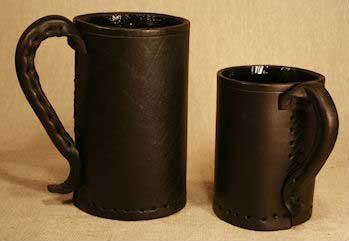 A Medieval style Jack has the same base diameter as the top at approx 10 cms, thus it is cylindrical. Large Jack approx 15cms high.
A Medieval style Jack has the same base diameter as the top at approx 10 cms, thus it is cylindrical. Large Jack approx 15cms high.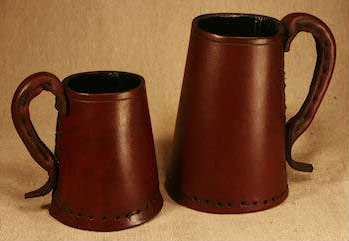 The Tudor style tankard has a broader base at 11.5cms than the top at approx 7.5cms and is conical.
The Tudor style tankard has a broader base at 11.5cms than the top at approx 7.5cms and is conical.